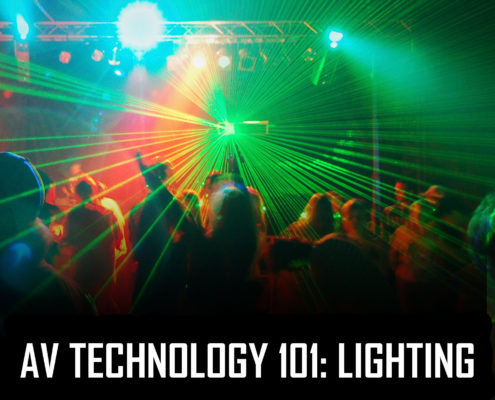AV Technology 101: Lighting
 Regardless of the type of event you are planning or the venue you’ve chosen for it, lighting will be a huge part of your planning and preparation. While it may seem like a small detail, lighting actually plays a large role in any successful event and can also be a source of many headaches if not planned for accordingly.
Regardless of the type of event you are planning or the venue you’ve chosen for it, lighting will be a huge part of your planning and preparation. While it may seem like a small detail, lighting actually plays a large role in any successful event and can also be a source of many headaches if not planned for accordingly.
There’s nothing worse than leaving an element of your event until the last minute, or forgetting about it completely, only to have it put a damper on the whole thing. We want to make sure that doesn’t happen to you during your event planning, which is why we’ve started this AV technology series. Even if you don’t end up doing the AV work yourself and end up bringing in a third-party AV service provider, you should still have a solid base knowledge of the elements in play, so that if you do need to hire out, you know what to look for in a vendor and can make sure they are providing you with everything you need to have a successful event.
Ok, back to lighting. As we’ve noted, lighting can play a large role in any event – no matter the size or location. So let’s take a look at our lighting options, when and where they are best used, and what to know about each.
AV Lighting
These are types of lighting options for your event along with details about when they are best used and what to know.
Intelligent lighting – Intelligent lights are all the rage for events right now and are a type of liights that are remotely controlled by computer and can be set to move anywhere around a room or stage in different patterns. This is great for large events or events where you want to use lighting to build up the crowd. It can be expensive, but it decreases the amount of engineers you need and increases your options – you aren’t roped into one lighting option for the entire event.
Spotlights – Spotlights are perfect for when you need concentrated light on a product, person, or area. Spotlights can add intrigue to an event and when used appropriately, can be a way to non-verbally highlight specific sections, products, or people throughout. Spotlights produce a narrow, tightly focused beam that’s perfect for podiums or signage
Follow spotlight – A follow spotlight is similar to regular spotlights, but they are a bit more versatile. Though you need a technician to operate them, a follow spotlight can be used to follow a performer on a stage or to light up different parts of the stage or area at different times during the event.
Fresnel – Fresnel lights are actually a lens that produces a “stepped” look with soft edges that create soft shadows rather than a flat look with sharp edges. Most often used for backlight or sidelight. This is a great lens to use when trying to provide high drama lighting for a performer or area of your stage. It gives depth and texture to your event with a simple lens.
Par Can – Par cans are essentially a floodlight that produces a wash of flat light evenly over a wide area. This is great for lighting up an entire stage at once or a dancefloor. These can also be used when doing product demos or other small offshoot events during a main event.
Gobo – Gobo – lights are fun for dances, parties, or other high-energy events. Gobos have a pattern pre-cut into a piece of thin metal that fits into a fixture to project logos or designs. This is also perfect for subtle brand or product placement as you can put words or logos into Gobo designs.
LED Lights – LED lights are a type of lighting device that uses less power, produces less heat and is more resistant to shock and vibration than brittle glass tubes or bulbs. Allows color mixtures of red, green and blue to create almost any color. These are perfect for when you want to change things up through the course of an event or want to add some flair to a main event stage.
Trees, poles, trusses – These are types of lighting structures that are used to support lights for special angles or flooding the stage. These are secondary lighting materials, but can play an important role in ensuring that your lighting is on-point.
This guide to AV lighting is just the first step to understanding your lighting needs, but we hope it’s been a good primer on what to look for or what questions to ask. If you have a question that was not answered here, please contact us or call (866)991-4818. We’ll be happy to help.

